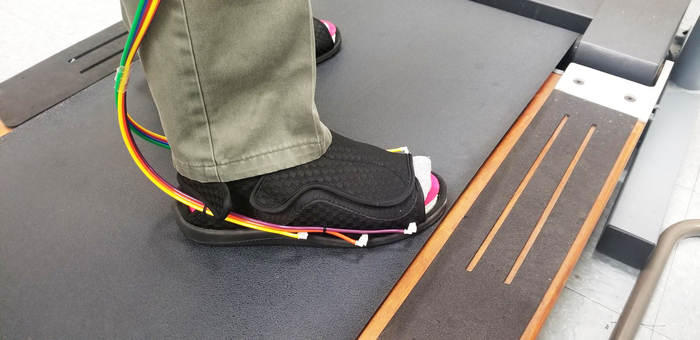Innovative footwear prevents diabetic foot ulcers
New footwear technology relieves pressure on areas of the feet that experience high stress during walking and other activities.

[Apr 3, 2022: Linsey Retcofsky, University of Texas at Arlington]
Dual-layer insole apparatus for diabetic foot lesion prevention. (CREDIT: The University of Texas at Arlington)
To prevent diabetic foot ulcers, research scientists at The University of Texas at Arlington have developed footwear technology that relieves pressure on areas of the feet that experience high stress during walking and other activities.
Muthu Wijesundara, principal research scientist and head of the Division of Biomedical Technologies at the University of Texas at Arlington Research Institute (UTARI), and his team have received a patent from the United States Patent and Trademark Office for a dual-layer insole apparatus for diabetic foot lesion prevention. The technology was developed in partnership with the University of North Texas Health Science Center.
Due to numbness in their legs and feet, people with diabetes often are unable to detect and respond to stress-related pain by adjusting their foot loading. This can result in repeated stress to high-pressure foot regions such as the heel or toes and can worsen blisters, sores and ulcers to the point of severe tissue loss or life-threatening infection. For many, foot ulcers can lead to amputation of a toe, foot or leg.
“Diabetes is a leading cause of amputation worldwide, and there is a major role that technology can play to prevent its devastating effects,” Wijesundara said. “We are now one step closer to finding a solution to reduce risk of complications related to diabetic foot ulcers.”
Related Stories
The removable shoe insole designed by Wijesundara’s team relieves stress by periodically regulating and redistributing pressure across all areas of the foot. Using fluid-filled cells, the dual-layer apparatus provides variability in a person’s foot-loading patterns to reduce prolonged pressure to any given area. The insole can automatically adjust and is designed to accommodate people of various weights.
In addition, the insole can be substituted for a total contact cast during the healing of a foot ulcer, and it can provide gait and ground force analysis.
Wijesundara’s team is working with the University of Texas Southwestern Medical Center on a pilot study funded by the National Institutes of Health to test initial prototypes.
“UTARI researchers develop advanced technologies to meet real-world challenges,” said Eileen Clements, UTARI interim executive director. “We are excited to witness the evolution of Dr. Wijesundara’s preventive care device and eager to see its continued development and the potential it may have to improve the quality of life for many people with diabetes.”
Note: Materials provided above by University of Texas at Arlington. Content may be edited for style and length.
Like these kind of feel good stories? Get the Brighter Side of News' newsletter.
Tags: #New_Innovations, #Shoes, #Diabetes, #Treatment, #Research, #Medical_News, #Ulcers, #Feet, #Walking, #Amputation, #The_Brighter_Side_of_News
Joseph Shavit
Head Science News Writer | Communicating Innovation & Discovery
Based in Los Angeles, Joseph Shavit is an accomplished science journalist, head science news writer and co-founder at The Brighter Side of News, where he translates cutting-edge discoveries into compelling stories for a broad audience. With a strong background spanning science, business, product management, media leadership, and entrepreneurship, Joseph brings a unique perspective to science communication. His expertise allows him to uncover the intersection of technological advancements and market potential, shedding light on how groundbreaking research evolves into transformative products and industries.



